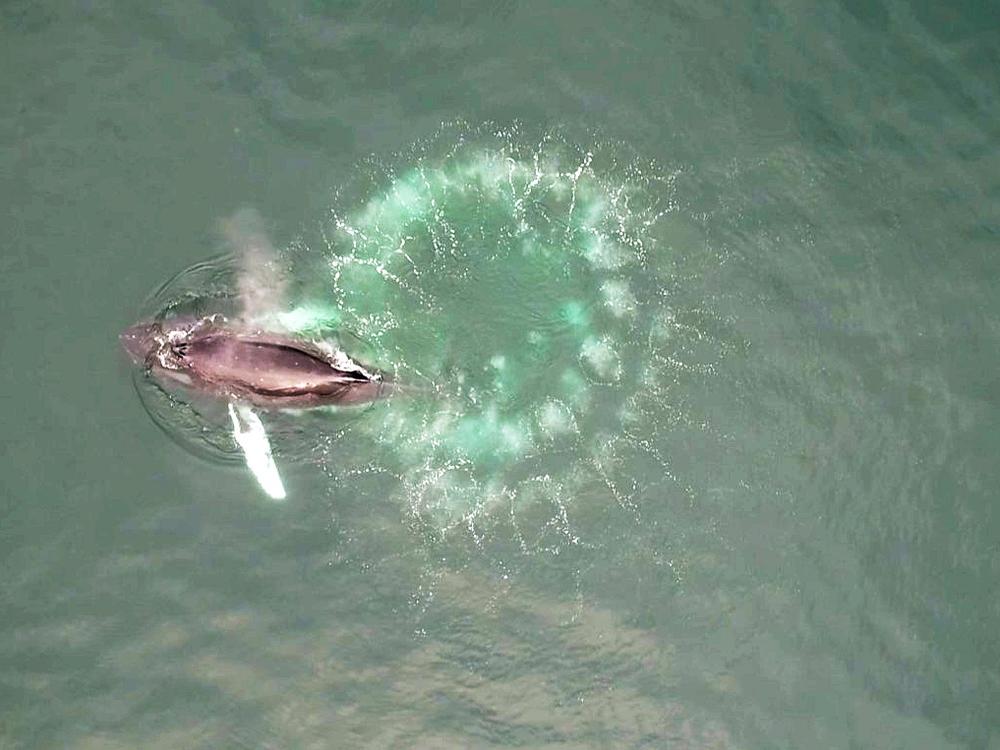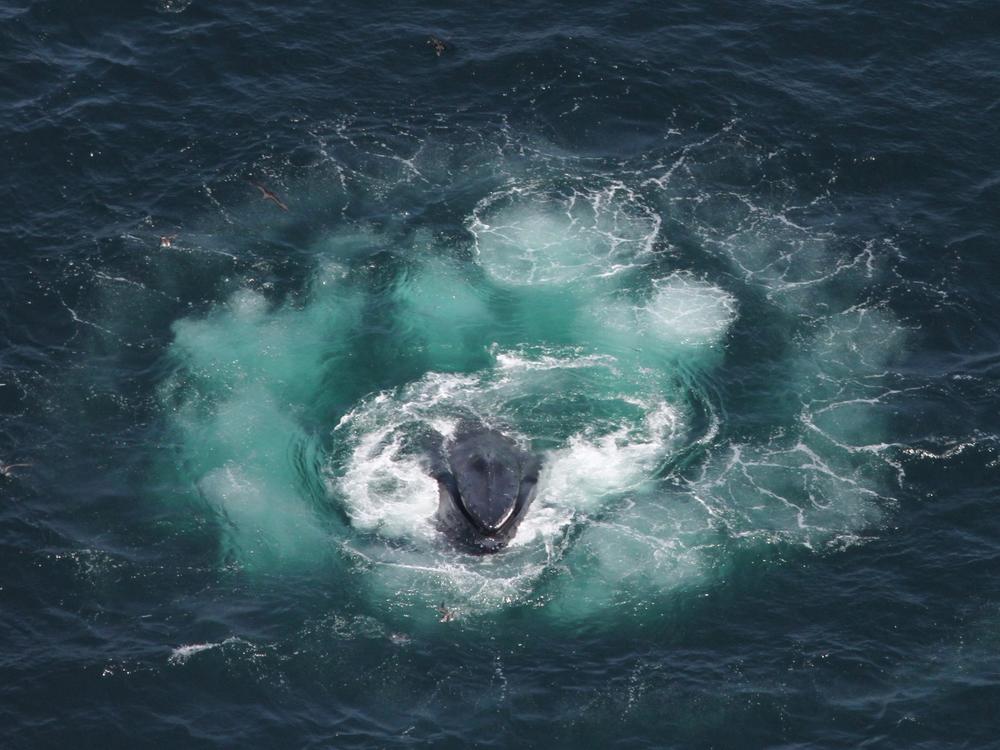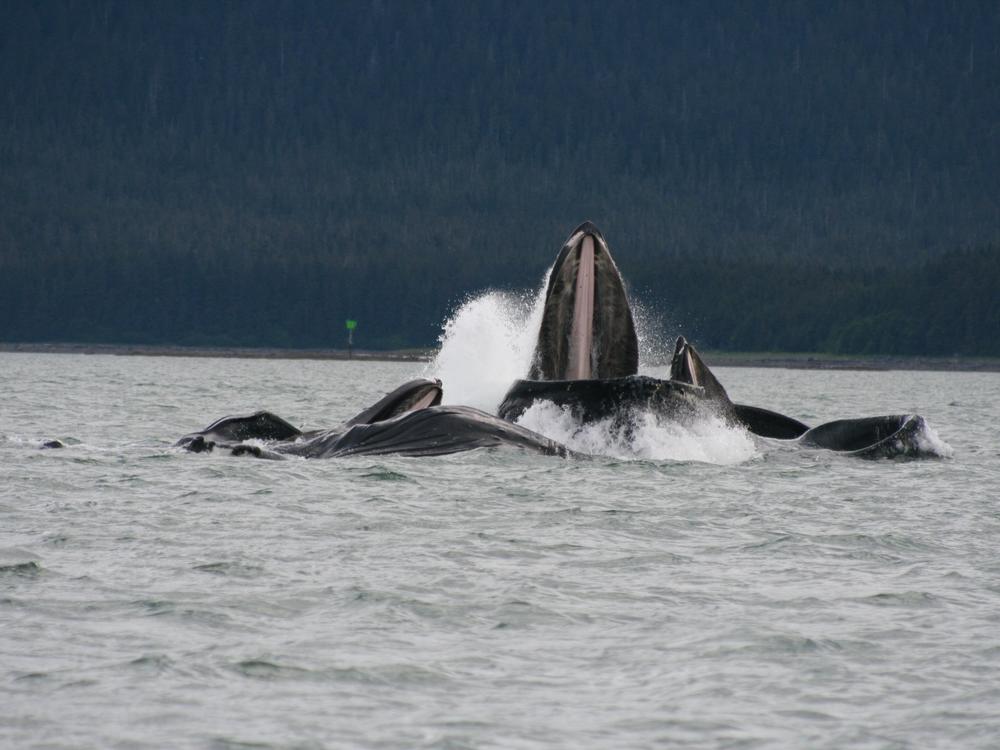Section Branding
Header Content
Humpback whales make custom fishing nets — out of bubbles
Primary Content
Some of the largest living animals on the planet eat the tiniest food. For humpback whales, it’s krill – small shrimp-like animals floating in the ocean. Capturing enough krill can take a lot of work, like if your morning bowl of cereal were spread out across a football field.
So humpbacks have developed a solution: bubbles.
The 50-foot whales blow circles of bubbles underwater, creating a net of air that entraps the krill. A new study shows that humpbacks can do this with remarkable precision to corral their prey, even tailoring the bubble nets for the type of food they’re eating.
“You realize how much control the animals are exerting over this,” says Andy Szabo, biologist and director of the Alaska Whale Foundation, who worked on the research. “It is not a random behavior. It’s a very structured, choreographed behavior.”
The researchers say it’s an example of tool use by animals, something that few other animals are known to do, like sea otters, monkeys, and crows.
“These whales are actually manufacturing these tools,” Szabo says. “And so we think that really elevates these animals, or it should elevate these animals in our own consciousness, in terms of their cognition.”
Casting a net of bubbles
Getting a whale’s eye view of dinnertime isn’t easy. To do it, Szabo and researchers from the University of Hawaiʻi at Mānoa used special suction-cup cameras with motion sensors that stick to the whale’s back. Attaching it requires a 20-foot pole and a bit of finesse. They also used drones for an aerial view.
In all, they documented more than 80 bubble nets in high detail in the waters of southeast Alaska.
The netting works like this: first, a humpback swims into a cloud of krill. Then, it starts swimming in a circle, blowing bubbles from its blowhole. The bubbles rise, creating a cylindrical shape with walls of air.
The krill avoid the bubbles, becoming trapped inside the net. The humpback keeps blowing bubbles, but in tighter circles.
“The circle is getting smaller and smaller and smaller so it’s creating a series of rings inside the net,” Szabo says. “They’re perfect nested rings within each ring.”
Finally, the humpback lunges upwards, gulping the krill in one big bite. The technique confines the krill into a much smaller space, increasing the density of the prey by about seven times, Szabo says.
“That translates to seven fewer mouthfuls that the whale needs to take to get the same amount of prey, so that seems to be where the big advantage is,” Szabo says. Humpbacks in Alaska don’t use bubble nets every time they feed on krill, suggesting they only use it when they need to.
For fish, humpbacks bubble net in groups
To catch fish, humpbacks deploy a different kind of bubble net. Herring are small schooling fish that are much faster swimmers than krill. So to corral them, humpbacks use teamwork.
One humpback blows a large bubble net around the herring. Then, a second whale makes a feeding call.
“It’s a loud, trumpeting sound and you can hear it through your boat hull,” says John Moran, biologist at NOAA’s Alaska Fisheries Science Center. “If you hear a feeding call, it’s time to move away because they’re going to come up somewhere close to you.”
Then, a group of whales all lunge upwards at the same time, scooping up the herring with gaping mouths. Humpbacks generally position themselves in the same order each time, sometimes as many as 15 whales at once.
“They’re basically doing the same thing that fishermen are doing,” Moran says. “They’re being smart about it. They’re making it more energetically efficient to forage that way.”
Getting the most calories per gulp is a key survival strategy for humpbacks that spend their summers in Alaska. Afterwards, they migrate thousands of miles to their breeding grounds in Hawaii or Mexico, where humpbacks don’t feed much. Packing on the pounds is crucial for that journey.
Climate change upsets the food chain
The flexibility that humpback whales use in bubble-netting is an example of tool use, Szabo says, which biologists define as when animals use something external to purposefully manipulate their environment.
“It really suggests that these whales have a toolkit,” Szabo says. “They’re trading out the net for whatever it is they’re targeting on that day, which is a pretty remarkable thing when you stop to think about it.”
It also shows that humpbacks are adaptable to their environment, tailoring their feeding techniques for different conditions. That seems to have helped humpback populations recover from the era of whaling faster than other whales.
Still, adaptability has its limits. In 2014, “the blob” hit the Pacific Ocean, where a marine heat wave dramatically increased ocean temperatures for several years. The entire food chain was affected, making it harder for humpbacks to feed.
“The prey was gone,” Moran says. “It cost them more to make a living. And we saw skinny whales, and the calf production dropped.”
Humpback whales in the North Pacific Ocean declined 20% from 2012 to 2021. With marine heat waves expected to become more frequent and intense with climate change, understanding how whales feed and the nuances of how they maximize their bubble nets could be crucial for conservation.
“It really starts to change our perception of these animals,” Szabo says. “That is very powerful when trying to convince people that there are remarkable animals out there and most of these animals are in jeopardy, unfortunately.”



